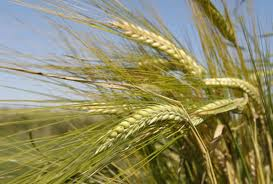Genetic diversity of barley verities by RAPD markers
Keywords:
Polymorphism, Cluster analysis, PCoAAbstract
The fourteen barleyverities were studied by RAPD markersto assessment of their genetic diversity. From 40 used primers, 17 primersestablished suitable banding patterns. Totally, 435 bands were produced between564- 4157 bp that all bands were polymorphic in varieties. The total mean ofmarkers for each primer was 25.59 and mean of polymorphic markers for eachprimer and variety were 27.9 and 22.29, respectively. “Gara Arapa” with 104 and“Gorgan” with 64 bands had the highest and lowest polymorphic bands,respectively. Primer 7 had the highest polymorphic band (35) and primer 11 hadthe lowest polymorphic band (13). Polymorphic information content (PIC) forprimers was estimated among 0.26 (Primer 2) and 0.48 (Primer 13) with mean0.34. Marker index (MI) varied among 2.01 to 8.97 in primers 2 and 7,respectively. Nei’s gene variation index was estimated 0.288for RAPD markers data. These amounts showed partly high diversity among understudied varieties. The genetic distance varied from 0.2509 between “Gara Arapa”and “Dari-Friz 88-A1” to 0.7135 between “Gohar Jo” and Dari-Friz 88- A7. TheCluster analysis based on Nei's genetic distance classified genotypes to threegroups. The first group contains Gorgan, Makui, Goharjo and Dari-Friz88-A1. Thesecond group contains Zarjo, Reihan, Karoon, Garearpa, Sahand, Valfajr andDari-Friz88-A7. The third group consists of Sina, Dari-Friz88-A3 andDari-Friz88-A5.
References
Behnia, M., 2005. Cold Season Cereals. Tehran University Publication (In Persian).
Farshadfar, E., 1997. Methodology of Plant Breeding. Qaghe Bostan Publications (In Persian).
Hong, Q., Hou, L., Luo, X., Li, D., Xiao, Y., Pei, Y., Yang, K., Jia, C., 2001. Using RAPD for evaluating genetic background among naked barley varieties in Sichuan Northwestern region. Sci. Agr. Sin., 34, 133-138.
Kochieva, E.Z., Goryunova, S.V., Pomortsev, A.A., 2001. RAPD analysis of the genomic in species of the genus Hordeum. Genetika-Moskova., 37, 1088-1094.
Kraic, J., Zakova, M., Gregova, E., 1998. Comparison of differentiation capability of RAPD and SSR markers in commercial barley (Hordeum vulgare L.) cultivars. Cereal Res. Commun., 26, 375-382.
Kroth, M.A., Ramella, M.S., Tagliari, C., Francisco, A., Arisi, A.C.M., 2005. Genetic similarity of Brazilian hulless and malting barley varieties evaluated by RAPD markers. Sci. Agr., 62, 36-39.
Mohammadi, S.A., 2001. Statistical methods in genetics. Proceedings of the 6th Statistics Conference, pp. 371-394. Tarbiat-Modares University, Augerst 24-28, Tehran, Iran (In Persian).
Rohlf, F.J., 1998. NTSYS-pc, Numerical taxonomy and multivariate analysis system. Version 2.0. Applied Biostatistics, New York.Selbach, A., Molina, S.C., 2000. RAPD characterization of Brazilian barley. Euphytica 111, 127-135.
Shi, Y.T., Bian, H.W., Han, N., Pan, J.W., Tong, W.X., Zhu, M.Y., 2004. Genetic variation analysis by RAPD of some barley cultivars in China. Acta Agr. Sin., 30, 256-265.
Zhang, D., Shi, Y., Li, S., 2005. Genetic variation analysis by RAPD of beer barley in China. J. Wuhan Botan. Res., 23, 305-309.

Published
How to Cite
Issue
Section
Copyright (c) 2013 A. Pourmohammad, D. Mahdavisafa

This work is licensed under a Creative Commons Attribution-NonCommercial-NoDerivatives 4.0 International License.



